Analyzing the Macroeconomic Outlook of Asia in the 21st Century
VerifiedAdded on 2021/08/31
|9
|2188
|60
Essay
AI Summary
This essay analyzes the proposition that the 21st century will be the 'Asian Century,' examining Asia's economic development and potential. The introduction establishes the context, highlighting Asia's growing global influence. The overview emphasizes Asia's historical achievements and current importance. The macroeconomic outlook explores socio-economic, industrial, and digital developments, supported by data and figures. The essay then identifies key challenges and risks, including income inequality, the status of middle-income countries, resource competition, domestic conflicts, and climate change. The conclusion reiterates Asia's rising role in the global arena while emphasizing the importance of mitigating risks. The analysis incorporates data from UNCTAD, IMF, and other sources, providing a comprehensive overview of Asia's economic trajectory and its implications for the future. The essay concludes by reinforcing Asia's potential to be a major player in the global stage, emphasizing the need to address challenges and risks to achieve this status.
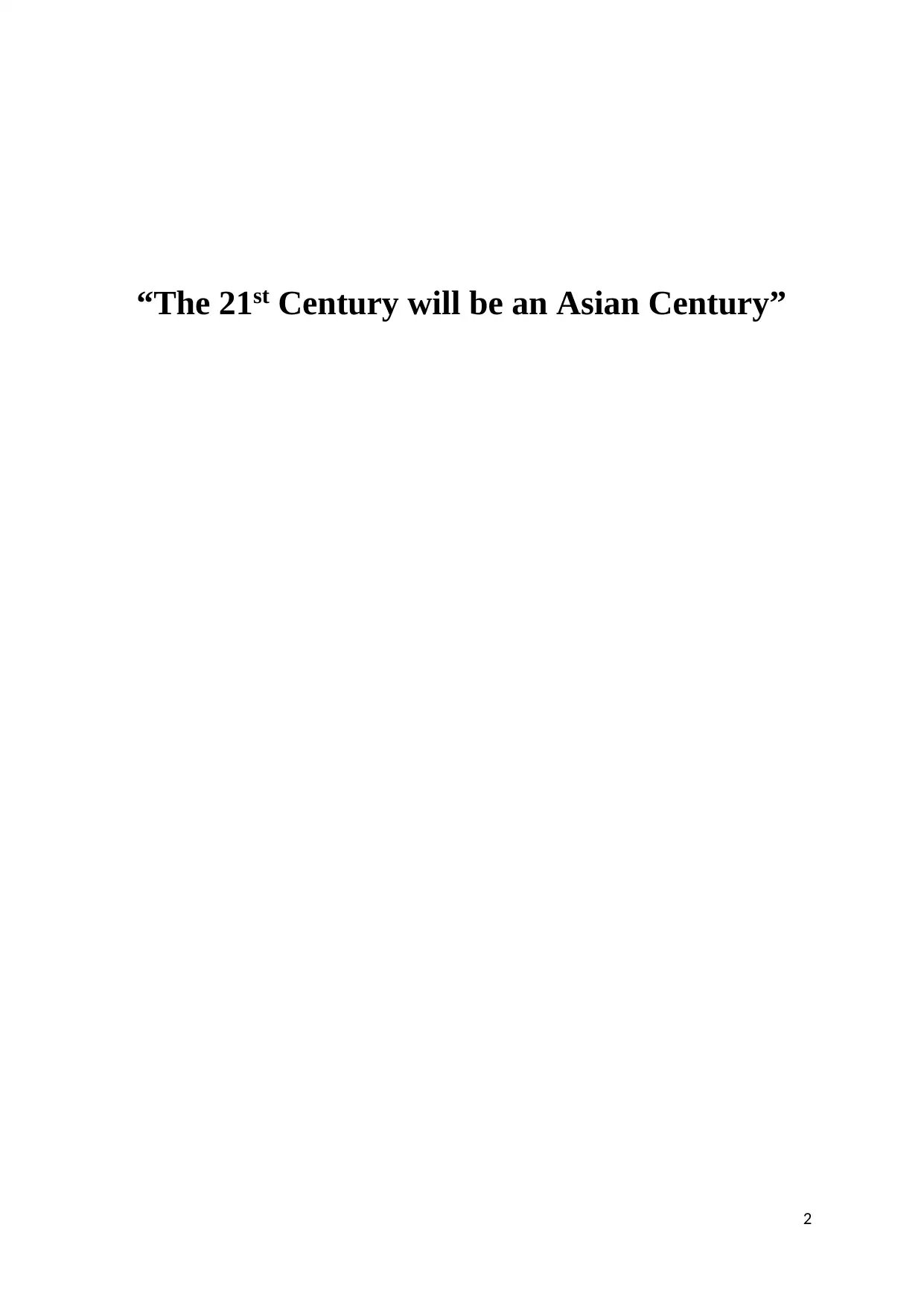
2
“The 21st Century will be an Asian Century”
“The 21st Century will be an Asian Century”
Paraphrase This Document
Need a fresh take? Get an instant paraphrase of this document with our AI Paraphraser
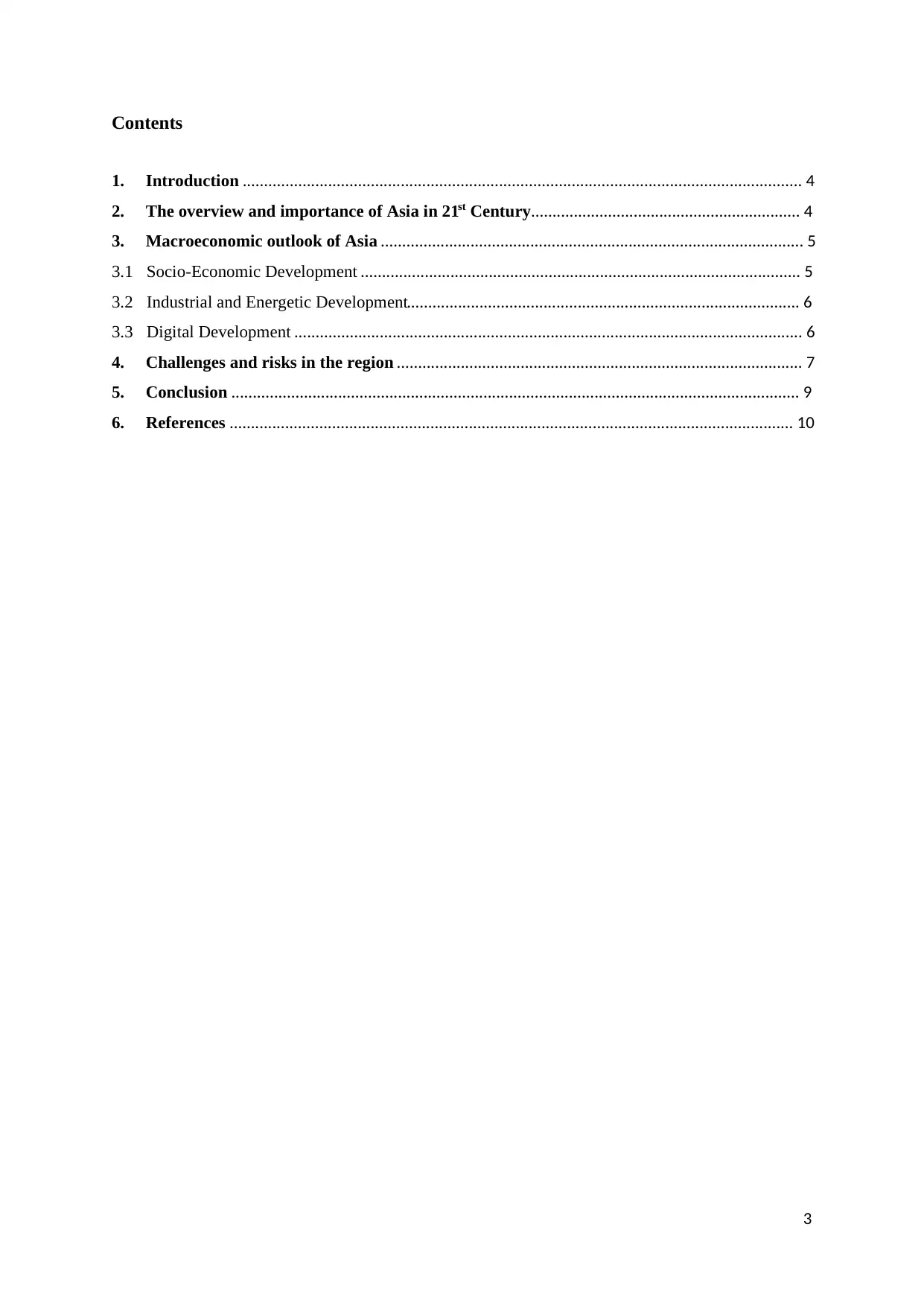
3
Contents
1. Introduction ................................................................................................................................... 4
2. The overview and importance of Asia in 21st Century............................................................... 4
3. Macroeconomic outlook of Asia ................................................................................................... 5
3.1 Socio-Economic Development ....................................................................................................... 5
3.2 Industrial and Energetic Development............................................................................................ 6
3.3 Digital Development ....................................................................................................................... 6
4. Challenges and risks in the region ............................................................................................... 7
5. Conclusion ..................................................................................................................................... 9
6. References .................................................................................................................................... 10
Contents
1. Introduction ................................................................................................................................... 4
2. The overview and importance of Asia in 21st Century............................................................... 4
3. Macroeconomic outlook of Asia ................................................................................................... 5
3.1 Socio-Economic Development ....................................................................................................... 5
3.2 Industrial and Energetic Development............................................................................................ 6
3.3 Digital Development ....................................................................................................................... 6
4. Challenges and risks in the region ............................................................................................... 7
5. Conclusion ..................................................................................................................................... 9
6. References .................................................................................................................................... 10
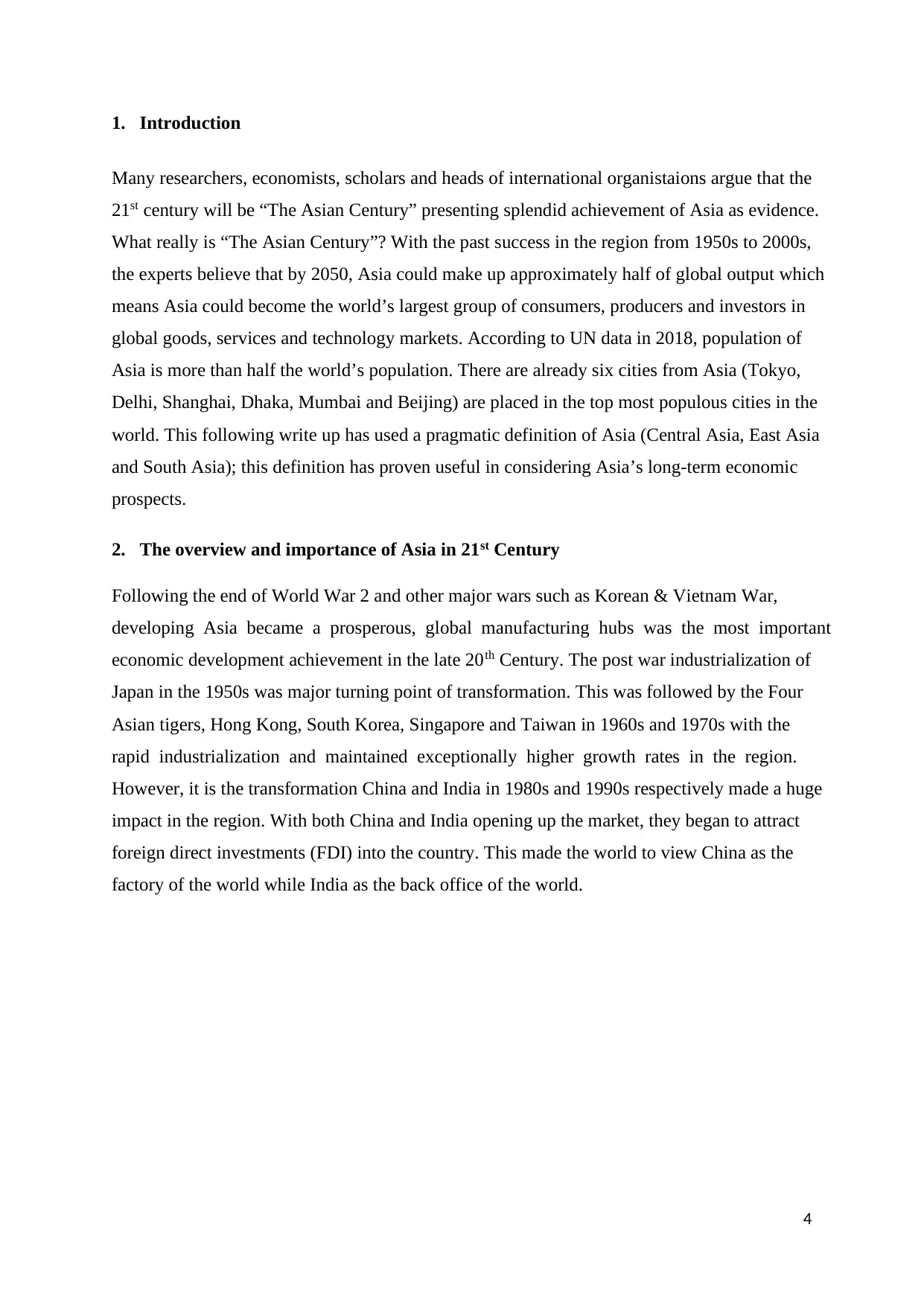
4
1. Introduction
Many researchers, economists, scholars and heads of international organistaions argue that the
21st century will be “The Asian Century” presenting splendid achievement of Asia as evidence.
What really is “The Asian Century”? With the past success in the region from 1950s to 2000s,
the experts believe that by 2050, Asia could make up approximately half of global output which
means Asia could become the world’s largest group of consumers, producers and investors in
global goods, services and technology markets. According to UN data in 2018, population of
Asia is more than half the world’s population. There are already six cities from Asia (Tokyo,
Delhi, Shanghai, Dhaka, Mumbai and Beijing) are placed in the top most populous cities in the
world. This following write up has used a pragmatic definition of Asia (Central Asia, East Asia
and South Asia); this definition has proven useful in considering Asia’s long-term economic
prospects.
2. The overview and importance of Asia in 21st Century
Following the end of World War 2 and other major wars such as Korean & Vietnam War,
developing Asia became a prosperous, global manufacturing hubs was the most important
economic development achievement in the late 20th Century. The post war industrialization of
Japan in the 1950s was major turning point of transformation. This was followed by the Four
Asian tigers, Hong Kong, South Korea, Singapore and Taiwan in 1960s and 1970s with the
rapid industrialization and maintained exceptionally higher growth rates in the region.
However, it is the transformation China and India in 1980s and 1990s respectively made a huge
impact in the region. With both China and India opening up the market, they began to attract
foreign direct investments (FDI) into the country. This made the world to view China as the
factory of the world while India as the back office of the world.
1. Introduction
Many researchers, economists, scholars and heads of international organistaions argue that the
21st century will be “The Asian Century” presenting splendid achievement of Asia as evidence.
What really is “The Asian Century”? With the past success in the region from 1950s to 2000s,
the experts believe that by 2050, Asia could make up approximately half of global output which
means Asia could become the world’s largest group of consumers, producers and investors in
global goods, services and technology markets. According to UN data in 2018, population of
Asia is more than half the world’s population. There are already six cities from Asia (Tokyo,
Delhi, Shanghai, Dhaka, Mumbai and Beijing) are placed in the top most populous cities in the
world. This following write up has used a pragmatic definition of Asia (Central Asia, East Asia
and South Asia); this definition has proven useful in considering Asia’s long-term economic
prospects.
2. The overview and importance of Asia in 21st Century
Following the end of World War 2 and other major wars such as Korean & Vietnam War,
developing Asia became a prosperous, global manufacturing hubs was the most important
economic development achievement in the late 20th Century. The post war industrialization of
Japan in the 1950s was major turning point of transformation. This was followed by the Four
Asian tigers, Hong Kong, South Korea, Singapore and Taiwan in 1960s and 1970s with the
rapid industrialization and maintained exceptionally higher growth rates in the region.
However, it is the transformation China and India in 1980s and 1990s respectively made a huge
impact in the region. With both China and India opening up the market, they began to attract
foreign direct investments (FDI) into the country. This made the world to view China as the
factory of the world while India as the back office of the world.
⊘ This is a preview!⊘
Do you want full access?
Subscribe today to unlock all pages.

Trusted by 1+ million students worldwide
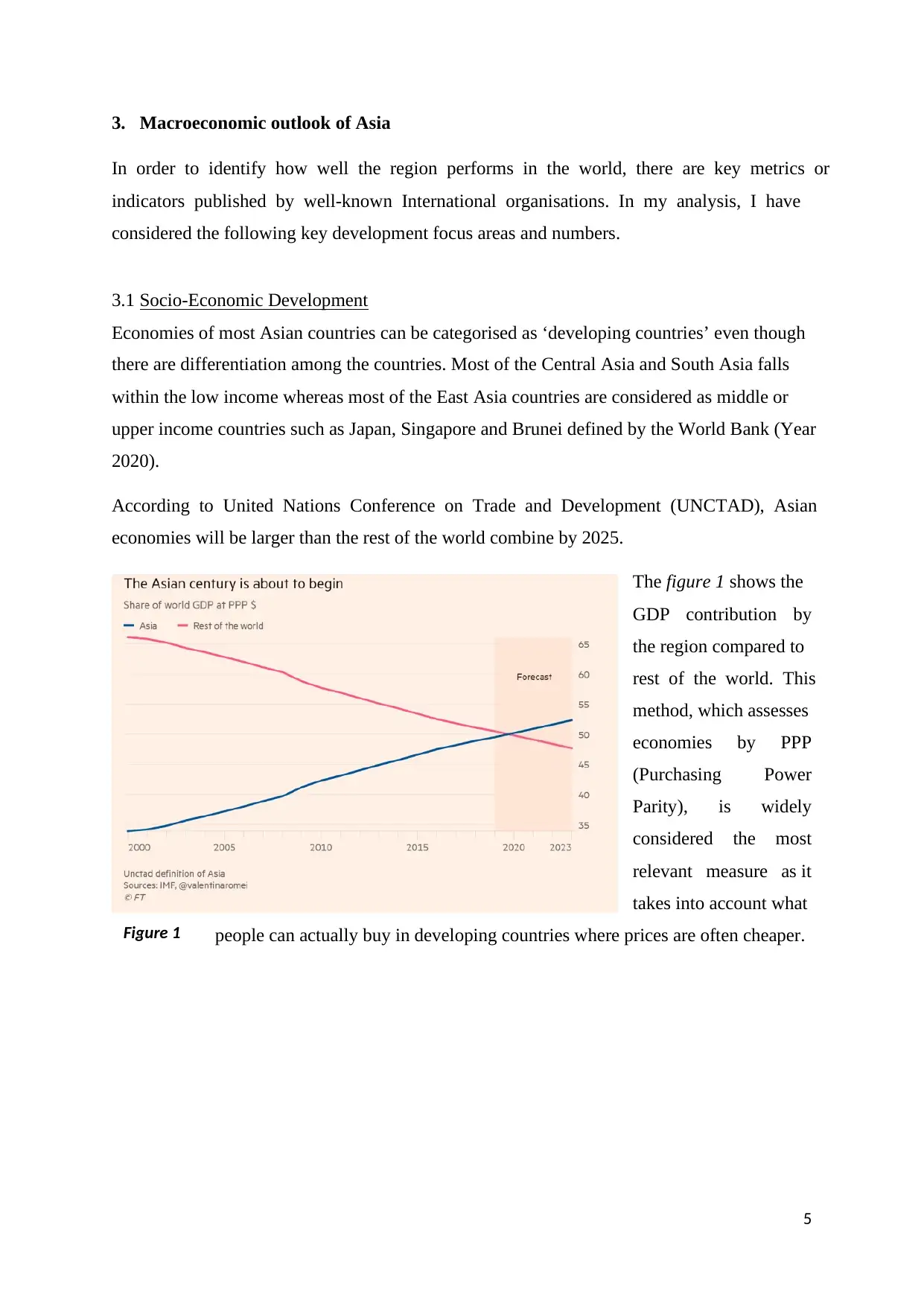
5
3. Macroeconomic outlook of Asia
In order to identify how well the region performs in the world, there are key metrics or
indicators published by well-known International organisations. In my analysis, I have
considered the following key development focus areas and numbers.
3.1 Socio-Economic Development
Economies of most Asian countries can be categorised as ‘developing countries’ even though
there are differentiation among the countries. Most of the Central Asia and South Asia falls
within the low income whereas most of the East Asia countries are considered as middle or
upper income countries such as Japan, Singapore and Brunei defined by the World Bank (Year
2020).
According to United Nations Conference on Trade and Development (UNCTAD), Asian
economies will be larger than the rest of the world combine by 2025.
The figure 1 shows the
GDP contribution by
the region compared to
rest of the world. This
method, which assesses
economies by PPP
(Purchasing Power
Parity), is widely
considered the most
relevant measure as it
takes into account what
people can actually buy in developing countries where prices are often cheaper.Figure 1
3. Macroeconomic outlook of Asia
In order to identify how well the region performs in the world, there are key metrics or
indicators published by well-known International organisations. In my analysis, I have
considered the following key development focus areas and numbers.
3.1 Socio-Economic Development
Economies of most Asian countries can be categorised as ‘developing countries’ even though
there are differentiation among the countries. Most of the Central Asia and South Asia falls
within the low income whereas most of the East Asia countries are considered as middle or
upper income countries such as Japan, Singapore and Brunei defined by the World Bank (Year
2020).
According to United Nations Conference on Trade and Development (UNCTAD), Asian
economies will be larger than the rest of the world combine by 2025.
The figure 1 shows the
GDP contribution by
the region compared to
rest of the world. This
method, which assesses
economies by PPP
(Purchasing Power
Parity), is widely
considered the most
relevant measure as it
takes into account what
people can actually buy in developing countries where prices are often cheaper.Figure 1
Paraphrase This Document
Need a fresh take? Get an instant paraphrase of this document with our AI Paraphraser
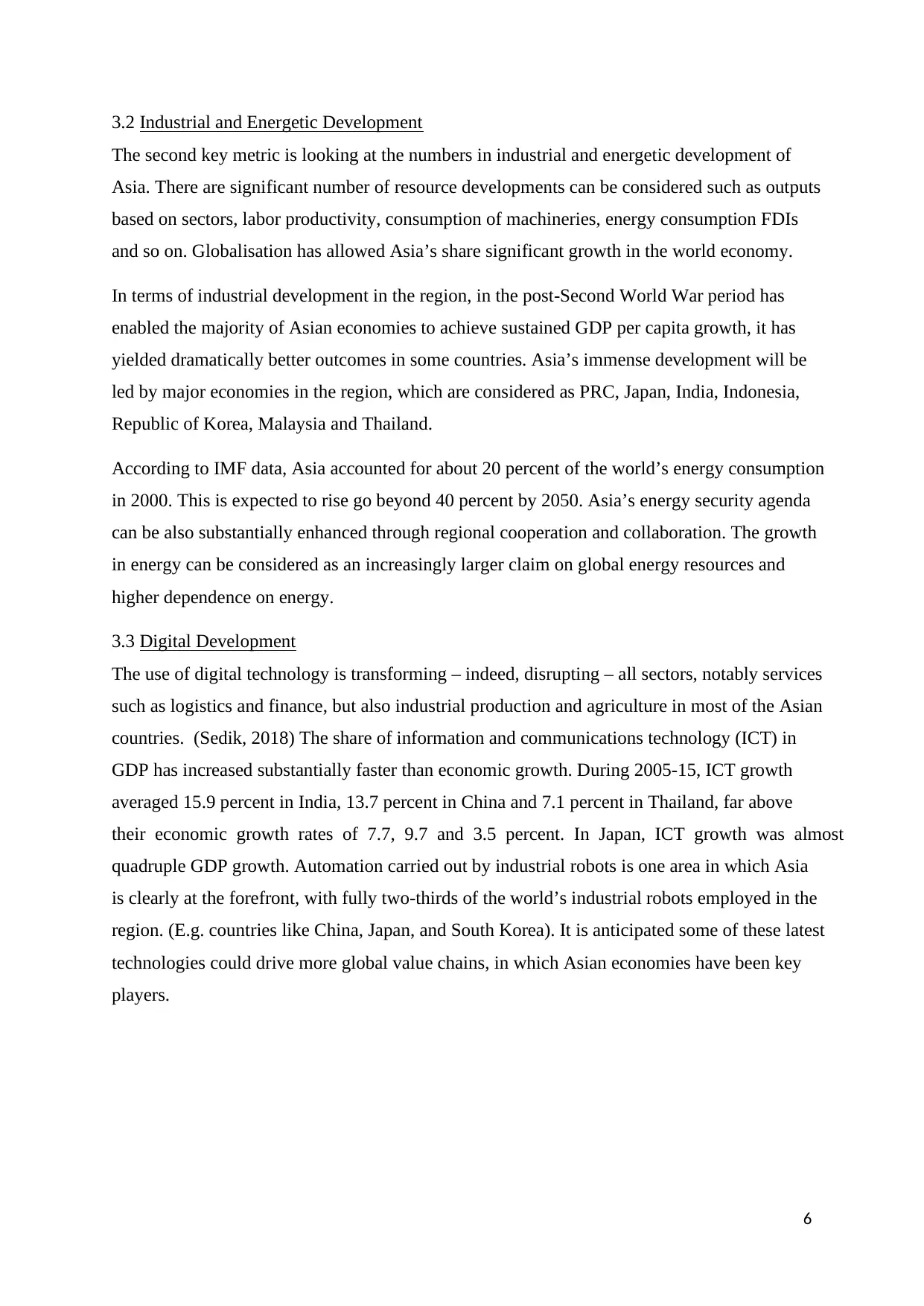
6
3.2 Industrial and Energetic Development
The second key metric is looking at the numbers in industrial and energetic development of
Asia. There are significant number of resource developments can be considered such as outputs
based on sectors, labor productivity, consumption of machineries, energy consumption FDIs
and so on. Globalisation has allowed Asia’s share significant growth in the world economy.
In terms of industrial development in the region, in the post-Second World War period has
enabled the majority of Asian economies to achieve sustained GDP per capita growth, it has
yielded dramatically better outcomes in some countries. Asia’s immense development will be
led by major economies in the region, which are considered as PRC, Japan, India, Indonesia,
Republic of Korea, Malaysia and Thailand.
According to IMF data, Asia accounted for about 20 percent of the world’s energy consumption
in 2000. This is expected to rise go beyond 40 percent by 2050. Asia’s energy security agenda
can be also substantially enhanced through regional cooperation and collaboration. The growth
in energy can be considered as an increasingly larger claim on global energy resources and
higher dependence on energy.
3.3 Digital Development
The use of digital technology is transforming – indeed, disrupting – all sectors, notably services
such as logistics and finance, but also industrial production and agriculture in most of the Asian
countries. (Sedik, 2018) The share of information and communications technology (ICT) in
GDP has increased substantially faster than economic growth. During 2005-15, ICT growth
averaged 15.9 percent in India, 13.7 percent in China and 7.1 percent in Thailand, far above
their economic growth rates of 7.7, 9.7 and 3.5 percent. In Japan, ICT growth was almost
quadruple GDP growth. Automation carried out by industrial robots is one area in which Asia
is clearly at the forefront, with fully two-thirds of the world’s industrial robots employed in the
region. (E.g. countries like China, Japan, and South Korea). It is anticipated some of these latest
technologies could drive more global value chains, in which Asian economies have been key
players.
3.2 Industrial and Energetic Development
The second key metric is looking at the numbers in industrial and energetic development of
Asia. There are significant number of resource developments can be considered such as outputs
based on sectors, labor productivity, consumption of machineries, energy consumption FDIs
and so on. Globalisation has allowed Asia’s share significant growth in the world economy.
In terms of industrial development in the region, in the post-Second World War period has
enabled the majority of Asian economies to achieve sustained GDP per capita growth, it has
yielded dramatically better outcomes in some countries. Asia’s immense development will be
led by major economies in the region, which are considered as PRC, Japan, India, Indonesia,
Republic of Korea, Malaysia and Thailand.
According to IMF data, Asia accounted for about 20 percent of the world’s energy consumption
in 2000. This is expected to rise go beyond 40 percent by 2050. Asia’s energy security agenda
can be also substantially enhanced through regional cooperation and collaboration. The growth
in energy can be considered as an increasingly larger claim on global energy resources and
higher dependence on energy.
3.3 Digital Development
The use of digital technology is transforming – indeed, disrupting – all sectors, notably services
such as logistics and finance, but also industrial production and agriculture in most of the Asian
countries. (Sedik, 2018) The share of information and communications technology (ICT) in
GDP has increased substantially faster than economic growth. During 2005-15, ICT growth
averaged 15.9 percent in India, 13.7 percent in China and 7.1 percent in Thailand, far above
their economic growth rates of 7.7, 9.7 and 3.5 percent. In Japan, ICT growth was almost
quadruple GDP growth. Automation carried out by industrial robots is one area in which Asia
is clearly at the forefront, with fully two-thirds of the world’s industrial robots employed in the
region. (E.g. countries like China, Japan, and South Korea). It is anticipated some of these latest
technologies could drive more global value chains, in which Asian economies have been key
players.
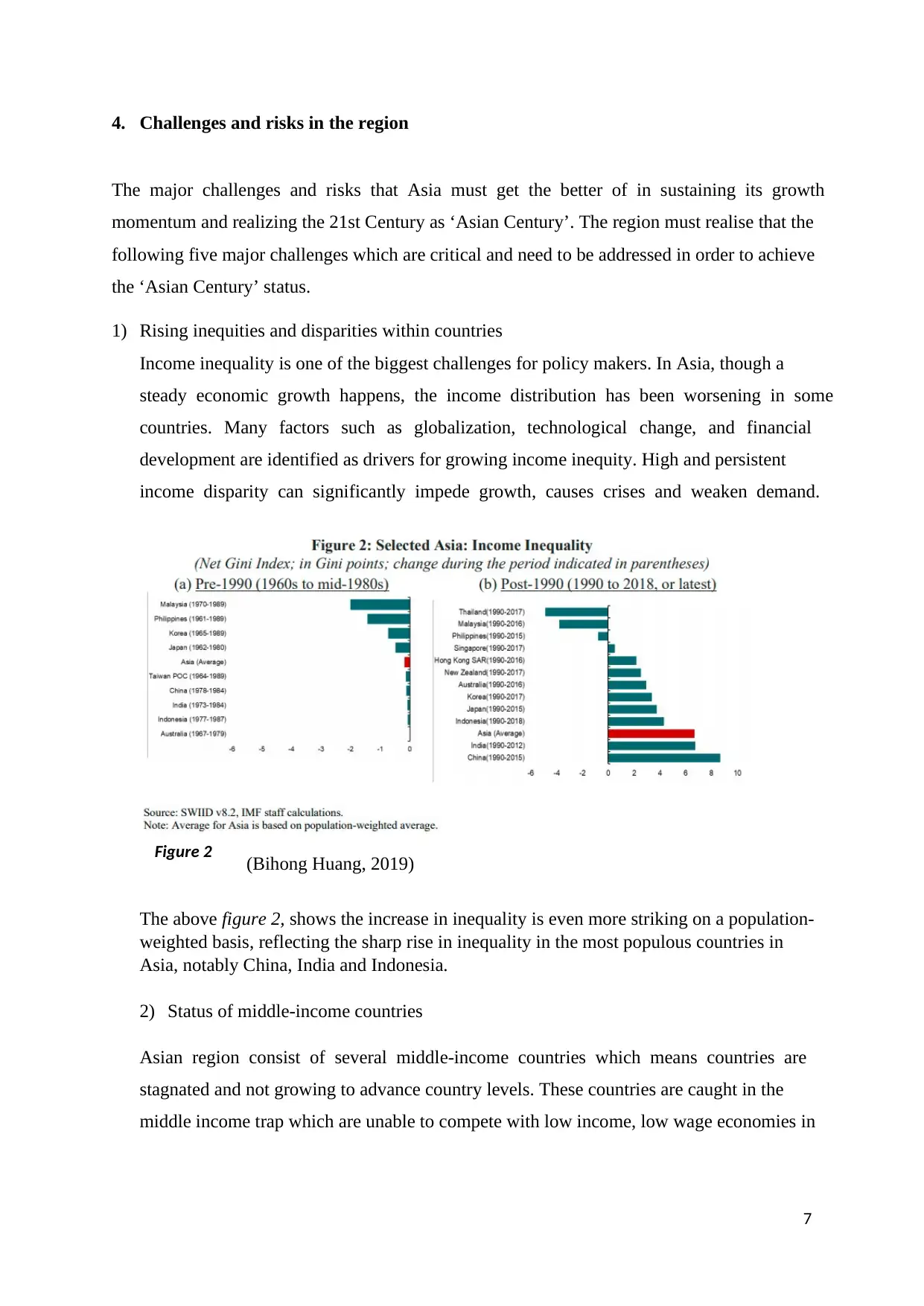
7
4. Challenges and risks in the region
The major challenges and risks that Asia must get the better of in sustaining its growth
momentum and realizing the 21st Century as ‘Asian Century’. The region must realise that the
following five major challenges which are critical and need to be addressed in order to achieve
the ‘Asian Century’ status.
1) Rising inequities and disparities within countries
Income inequality is one of the biggest challenges for policy makers. In Asia, though a
steady economic growth happens, the income distribution has been worsening in some
countries. Many factors such as globalization, technological change, and financial
development are identified as drivers for growing income inequity. High and persistent
income disparity can significantly impede growth, causes crises and weaken demand.
(Bihong Huang, 2019)
The above figure 2, shows the increase in inequality is even more striking on a population-
weighted basis, reflecting the sharp rise in inequality in the most populous countries in
Asia, notably China, India and Indonesia.
2) Status of middle-income countries
Asian region consist of several middle-income countries which means countries are
stagnated and not growing to advance country levels. These countries are caught in the
middle income trap which are unable to compete with low income, low wage economies in
Figure 2
4. Challenges and risks in the region
The major challenges and risks that Asia must get the better of in sustaining its growth
momentum and realizing the 21st Century as ‘Asian Century’. The region must realise that the
following five major challenges which are critical and need to be addressed in order to achieve
the ‘Asian Century’ status.
1) Rising inequities and disparities within countries
Income inequality is one of the biggest challenges for policy makers. In Asia, though a
steady economic growth happens, the income distribution has been worsening in some
countries. Many factors such as globalization, technological change, and financial
development are identified as drivers for growing income inequity. High and persistent
income disparity can significantly impede growth, causes crises and weaken demand.
(Bihong Huang, 2019)
The above figure 2, shows the increase in inequality is even more striking on a population-
weighted basis, reflecting the sharp rise in inequality in the most populous countries in
Asia, notably China, India and Indonesia.
2) Status of middle-income countries
Asian region consist of several middle-income countries which means countries are
stagnated and not growing to advance country levels. These countries are caught in the
middle income trap which are unable to compete with low income, low wage economies in
Figure 2
⊘ This is a preview!⊘
Do you want full access?
Subscribe today to unlock all pages.

Trusted by 1+ million students worldwide
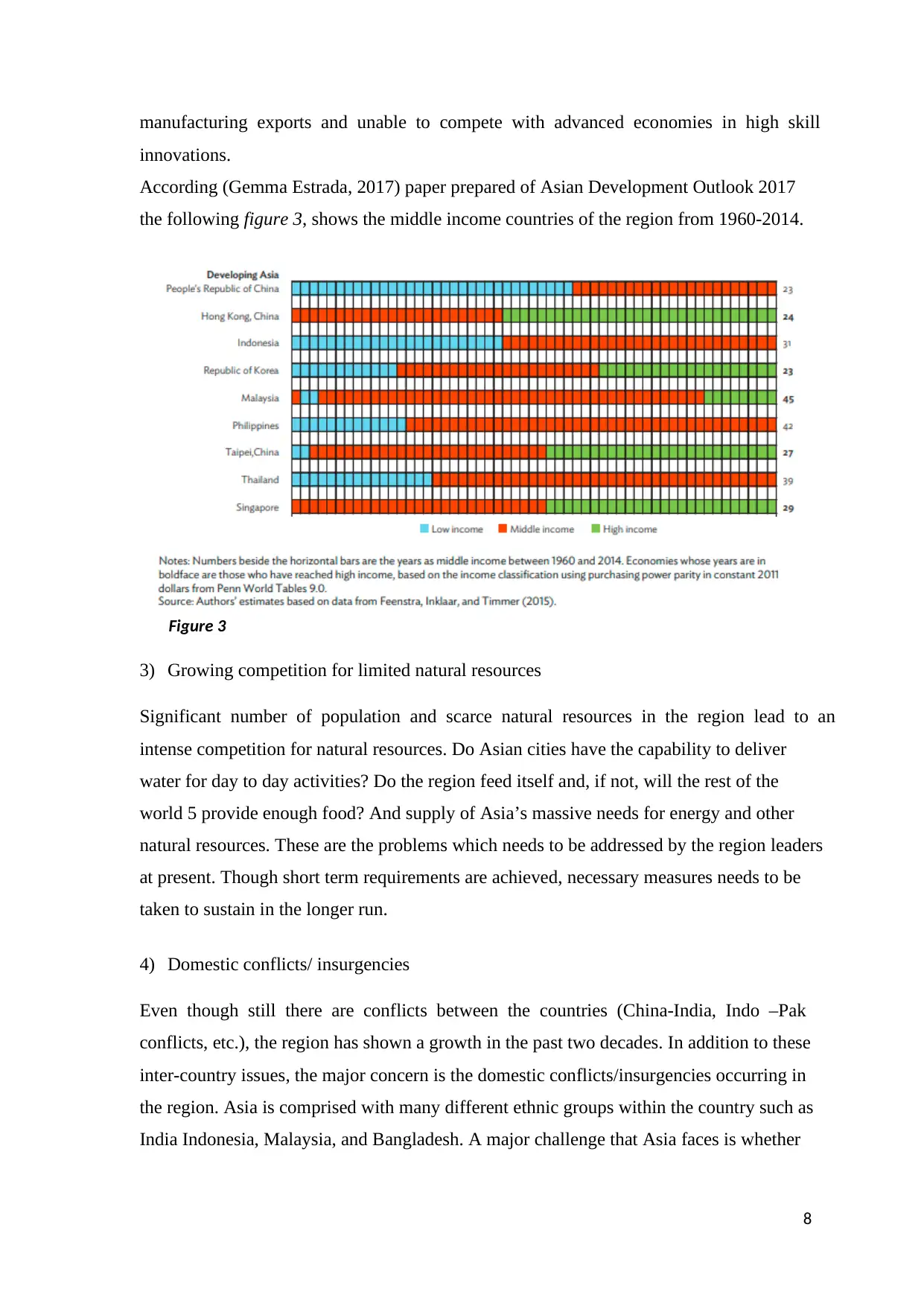
8
manufacturing exports and unable to compete with advanced economies in high skill
innovations.
According (Gemma Estrada, 2017) paper prepared of Asian Development Outlook 2017
the following figure 3, shows the middle income countries of the region from 1960-2014.
3) Growing competition for limited natural resources
Significant number of population and scarce natural resources in the region lead to an
intense competition for natural resources. Do Asian cities have the capability to deliver
water for day to day activities? Do the region feed itself and, if not, will the rest of the
world 5 provide enough food? And supply of Asia’s massive needs for energy and other
natural resources. These are the problems which needs to be addressed by the region leaders
at present. Though short term requirements are achieved, necessary measures needs to be
taken to sustain in the longer run.
4) Domestic conflicts/ insurgencies
Even though still there are conflicts between the countries (China-India, Indo –Pak
conflicts, etc.), the region has shown a growth in the past two decades. In addition to these
inter-country issues, the major concern is the domestic conflicts/insurgencies occurring in
the region. Asia is comprised with many different ethnic groups within the country such as
India Indonesia, Malaysia, and Bangladesh. A major challenge that Asia faces is whether
Figure 3
manufacturing exports and unable to compete with advanced economies in high skill
innovations.
According (Gemma Estrada, 2017) paper prepared of Asian Development Outlook 2017
the following figure 3, shows the middle income countries of the region from 1960-2014.
3) Growing competition for limited natural resources
Significant number of population and scarce natural resources in the region lead to an
intense competition for natural resources. Do Asian cities have the capability to deliver
water for day to day activities? Do the region feed itself and, if not, will the rest of the
world 5 provide enough food? And supply of Asia’s massive needs for energy and other
natural resources. These are the problems which needs to be addressed by the region leaders
at present. Though short term requirements are achieved, necessary measures needs to be
taken to sustain in the longer run.
4) Domestic conflicts/ insurgencies
Even though still there are conflicts between the countries (China-India, Indo –Pak
conflicts, etc.), the region has shown a growth in the past two decades. In addition to these
inter-country issues, the major concern is the domestic conflicts/insurgencies occurring in
the region. Asia is comprised with many different ethnic groups within the country such as
India Indonesia, Malaysia, and Bangladesh. A major challenge that Asia faces is whether
Figure 3
Paraphrase This Document
Need a fresh take? Get an instant paraphrase of this document with our AI Paraphraser
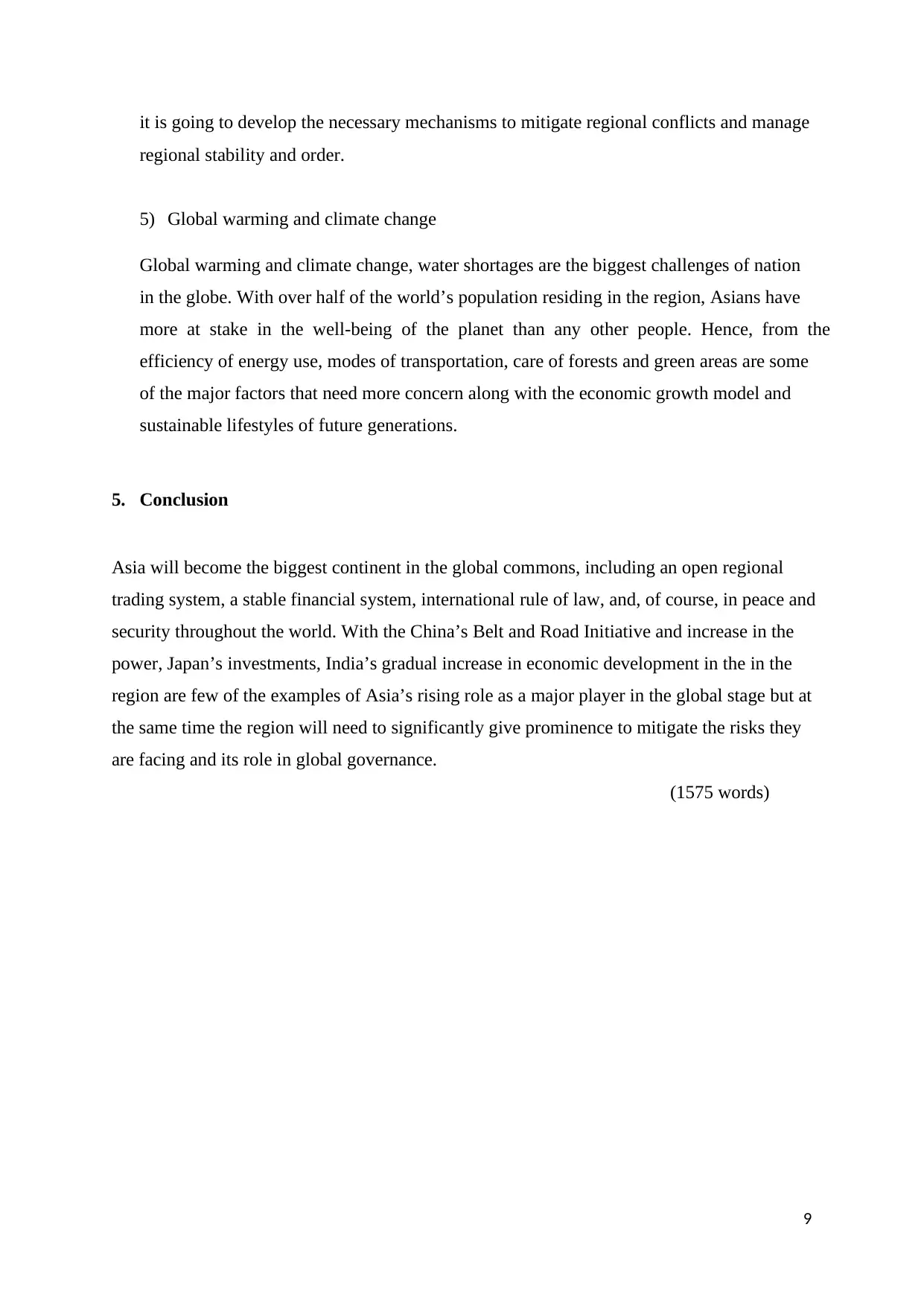
9
it is going to develop the necessary mechanisms to mitigate regional conflicts and manage
regional stability and order.
5) Global warming and climate change
Global warming and climate change, water shortages are the biggest challenges of nation
in the globe. With over half of the world’s population residing in the region, Asians have
more at stake in the well-being of the planet than any other people. Hence, from the
efficiency of energy use, modes of transportation, care of forests and green areas are some
of the major factors that need more concern along with the economic growth model and
sustainable lifestyles of future generations.
5. Conclusion
Asia will become the biggest continent in the global commons, including an open regional
trading system, a stable financial system, international rule of law, and, of course, in peace and
security throughout the world. With the China’s Belt and Road Initiative and increase in the
power, Japan’s investments, India’s gradual increase in economic development in the in the
region are few of the examples of Asia’s rising role as a major player in the global stage but at
the same time the region will need to significantly give prominence to mitigate the risks they
are facing and its role in global governance.
(1575 words)
it is going to develop the necessary mechanisms to mitigate regional conflicts and manage
regional stability and order.
5) Global warming and climate change
Global warming and climate change, water shortages are the biggest challenges of nation
in the globe. With over half of the world’s population residing in the region, Asians have
more at stake in the well-being of the planet than any other people. Hence, from the
efficiency of energy use, modes of transportation, care of forests and green areas are some
of the major factors that need more concern along with the economic growth model and
sustainable lifestyles of future generations.
5. Conclusion
Asia will become the biggest continent in the global commons, including an open regional
trading system, a stable financial system, international rule of law, and, of course, in peace and
security throughout the world. With the China’s Belt and Road Initiative and increase in the
power, Japan’s investments, India’s gradual increase in economic development in the in the
region are few of the examples of Asia’s rising role as a major player in the global stage but at
the same time the region will need to significantly give prominence to mitigate the risks they
are facing and its role in global governance.
(1575 words)
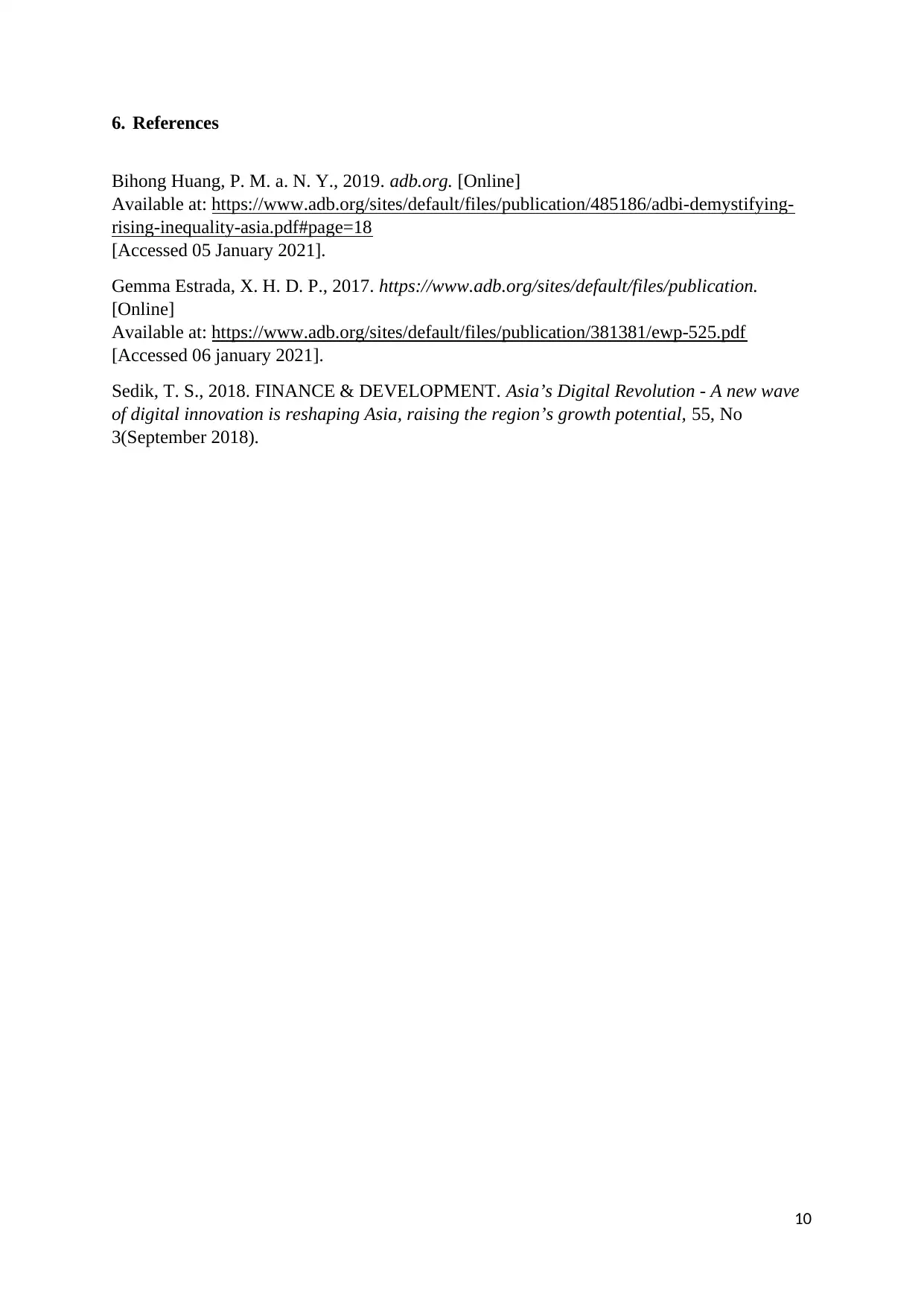
10
6. References
Bihong Huang, P. M. a. N. Y., 2019. adb.org. [Online]
Available at: https://www.adb.org/sites/default/files/publication/485186/adbi-demystifying-
rising-inequality-asia.pdf#page=18
[Accessed 05 January 2021].
Gemma Estrada, X. H. D. P., 2017. https://www.adb.org/sites/default/files/publication.
[Online]
Available at: https://www.adb.org/sites/default/files/publication/381381/ewp-525.pdf
[Accessed 06 january 2021].
Sedik, T. S., 2018. FINANCE & DEVELOPMENT. Asia’s Digital Revolution - A new wave
of digital innovation is reshaping Asia, raising the region’s growth potential, 55, No
3(September 2018).
6. References
Bihong Huang, P. M. a. N. Y., 2019. adb.org. [Online]
Available at: https://www.adb.org/sites/default/files/publication/485186/adbi-demystifying-
rising-inequality-asia.pdf#page=18
[Accessed 05 January 2021].
Gemma Estrada, X. H. D. P., 2017. https://www.adb.org/sites/default/files/publication.
[Online]
Available at: https://www.adb.org/sites/default/files/publication/381381/ewp-525.pdf
[Accessed 06 january 2021].
Sedik, T. S., 2018. FINANCE & DEVELOPMENT. Asia’s Digital Revolution - A new wave
of digital innovation is reshaping Asia, raising the region’s growth potential, 55, No
3(September 2018).
⊘ This is a preview!⊘
Do you want full access?
Subscribe today to unlock all pages.

Trusted by 1+ million students worldwide
1 out of 9
Related Documents
Your All-in-One AI-Powered Toolkit for Academic Success.
+13062052269
info@desklib.com
Available 24*7 on WhatsApp / Email
![[object Object]](/_next/static/media/star-bottom.7253800d.svg)
Unlock your academic potential
Copyright © 2020–2025 A2Z Services. All Rights Reserved. Developed and managed by ZUCOL.





